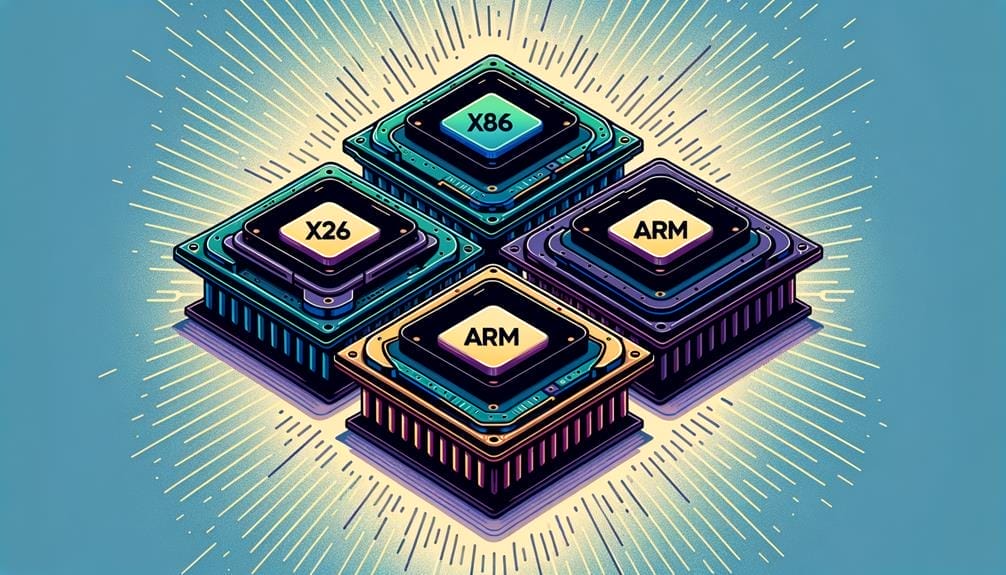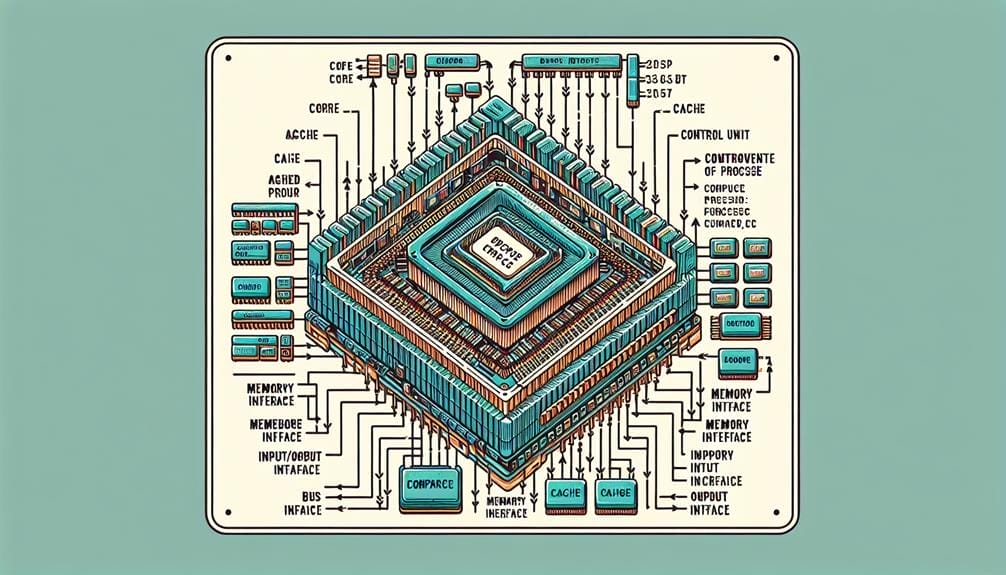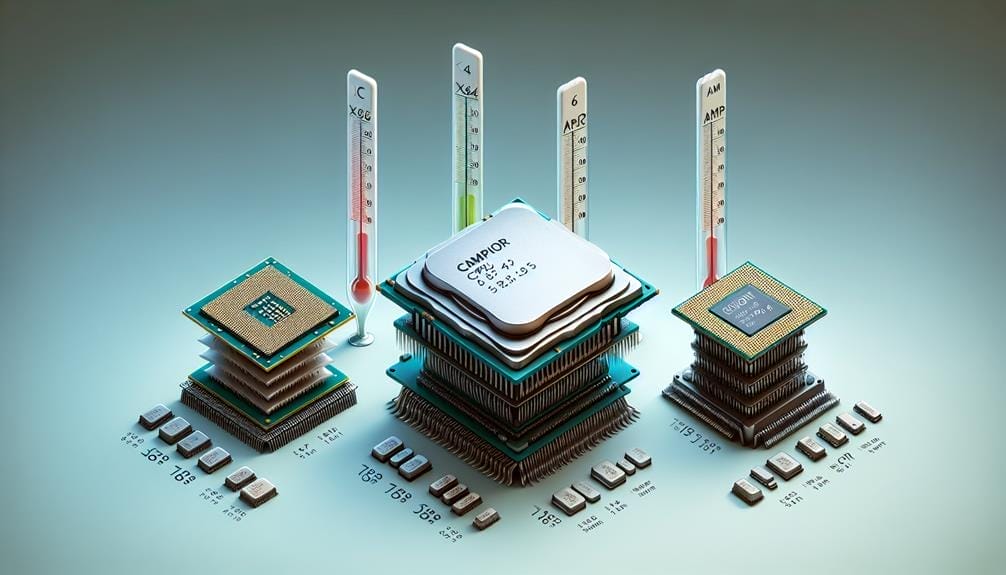CPU Showdown: X86, X64, ARM Face-Off

In the ever-evolving world of computer science, the brains of our machines—known as CPUs—and their distinct languages become more and more crucial. The differences between x86, x64, and ARM might seem small, but boy, they pack a big punch! These are the secret sauces that make our gadgets and tech come alive.
Each architecture possesses its own unique characteristics, from processing power to power efficiency, and understanding these distinctions is essential for anyone navigating the ever-expanding landscape of computing technology.
As we embark on this exploration, we will uncover the nuanced differences that set these architectures apart, providing valuable insights for those seeking to make informed decisions in the realm of CPU technology.
Key Takeaways
- x86 is a 32-bit CPU architecture with a 4 GB RAM limitation, while x64 and ARM have higher memory capacity in the terabytes.
- x64 is the dominant architecture for high-end applications, offering greater processing power compared to x86 and ARM.
- ARM architecture is known for its power efficiency, making it popular for smart devices and low-power PCs.
- ARM devices are often more affordable due to the cheaper licensing, resulting in devices like Raspberry Pi and budget smartphones.
X86 Architecture Overview

The x86 architecture, also known as the 32-bit architecture, has played a pivotal role in the evolution of personal computing since its inception in 1978. Its widespread adoption can be attributed to its compatibility with a vast array of software and its relatively simple design, making it cost-effective to produce.
However, x86 architecture also has limitations, particularly its 4 GB RAM restriction, which hinders its ability to efficiently run modern software and handle large datasets. Despite this limitation, x86 architecture continues to be utilized in various applications due to its established ecosystem and the extensive knowledge base built around it.
Understanding the advantages and limitations of x86 architecture is crucial for making informed decisions when selecting hardware for specific computing needs.
X64 Architecture Breakdown
Pivotal to the evolution of personal computing, the x86 architecture's limitations, particularly its 4 GB RAM restriction, have prompted the widespread adoption of the x64 architecture, which offers expanded memory capabilities and enhanced performance for modern computing needs. The x64 architecture provides superior performance and capabilities compared to x86, making it the architecture of choice for contemporary computing requirements.
x64 Architecture Advantages:
- Memory Capacity: x64 supports higher RAM limits, up to 16.8 million TB theoretically.
- Processing Power: x64 outperforms x86, especially for high-end applications.
- Power Efficiency: Although x64 is powerful, ARM architecture is more power-efficient due to its Reduced Instruction Set.
- Cooling Requirements: x64 devices may require more elaborate cooling solutions due to higher power consumption.
In the x64 vs x86 comparison, it's evident that x64 architecture offers substantial improvements in performance and memory capacity, making it the preferred choice for modern computing needs.
ARM Architecture Insights

An examination of ARM architecture reveals its significance in the landscape of smart devices and low-power computing systems, underscoring its growing impact and potential as a viable alternative to x86 and x64 architectures.
While x86 and x64 architectures have historically dominated the PC market, ARM's adoption in this space is gaining momentum, particularly with Apple's transition to ARM architecture for their desktop Macs. ARM's power efficiency and reduced instruction set make it an attractive option for low-power PCs.
In terms of performance, ARM has traditionally lagged behind x86 and x64 architectures in high-end applications, but advancements in ARM-based processors are closing this gap.
Furthermore, ARM's lower licensing costs enable the production of affordable devices, expanding its presence in the market.
As ARM continues to evolve, its competition with x86 and x64 architectures in the PC market is likely to intensify.
Memory and Processing Capabilities
Comparing the memory and processing capabilities of x86, x64, and ARM architectures provides insights into their respective performance and potential for various computing applications.
- Memory Scalability:
- x86 has a 4 GB RAM limitation, while x64 and ARM have higher limits in the terabytes.
- Performance Comparison:
- x64 is the dominant complex CPU architecture, especially for high-end applications.
- Power Consumption:
- ARM devices are more power-efficient due to their Reduced Instruction Set.
- Cooling Requirements:
- ARM devices generate less heat and often do not require cooling fans.
These factors highlight the diverse capabilities and trade-offs among x86, x64, and ARM architectures, influencing their suitability for different computing needs.
Energy Efficiency and Cooling

The examination of energy efficiency and cooling in x86, x64, and ARM architectures is essential for understanding their practical implementation in various computing environments.
When comparing energy efficiency, ARM stands out due to its Reduced Instruction Set, consuming less power than x86 and x64. This makes ARM particularly suitable for smart devices and low-power PCs.
Additionally, ARM devices generate less heat, often eliminating the need for cooling fans, which has implications for form factor design and noise reduction.
In contrast, x86 and x64 architectures, especially in high-performance applications, require more advanced cooling solutions to manage their higher power consumption and heat generation.
Understanding these differences in energy efficiency and cooling is crucial for selecting the appropriate architecture for specific computing needs.
Pricing and Market Impact
Pricing and market impact analysis of x86, x64, and ARM architectures is crucial for understanding their competitive positioning and industry adoption trends.
The impact of ARM adoption on PC industry pricing and ARM vs x86 market competition can be summarized as follows:
- Affordability: ARM is cheaper to license, leading to the availability of budget-friendly devices like Raspberry Pi and entry-level smartphones.
- Market Disruption: The increasing adoption of ARM in the PC space alongside x86 and x64 architectures is disrupting the traditional market dynamics, challenging established players.
- Diversification: ARM's presence in the PC industry is diversifying the market, offering consumers a wider range of options in terms of pricing and performance.
- Competitive Pressure: ARM's cost-effective nature is putting pressure on x86 manufacturers to reconsider pricing strategies and potentially adjust their pricing models to remain competitive.
This shift in market dynamics reflects the ongoing evolution of the CPU landscape, with implications for both consumers and industry stakeholders.
Conclusion
In conclusion, the comparison of x86, x64, and ARM architectures reveals distinct micro-architectural intricacies and instruction sets that influence performance, compatibility, power efficiency, and pricing.
Each architecture offers unique advantages and limitations, shaping their market impact and technological advancements.
Understanding the nuances of these prominent CPU architectures is crucial for informed decision-making in the realm of computing technology.

